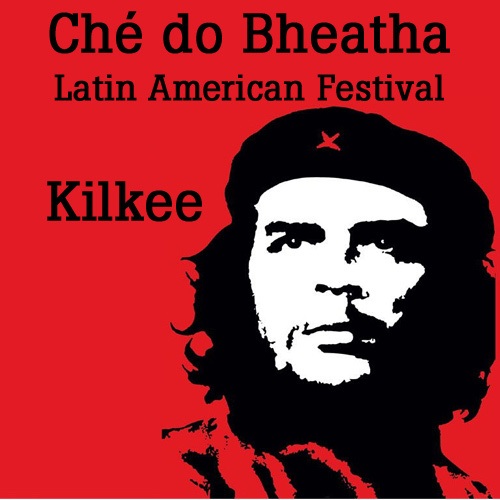
Poster for the annual Che do Bheatha Festival in Kilkee, Ireland.
October 9th 2017 marks 50 years since the death of Che Guevara, the world’s most famously photogenic rebel! In the aftermath of the 39 year old’s death, Che’s father spoke about his son and singled out his heritage as the roots for his rebellious streak:
“The first thing to note is that in my son’s veins flowed the blood of Irish rebels.”
Che was born into a well-to-do family in Buenos Aires in 1928, the eldest child of Celia de la Serna and Ernesto Guevara Lynch. When Che’s family ran into financial difficulty and lost most of their land, they moved into an apartment with Ernesto’s mother Ana Isabel Lynch, the daughter of an Irish immigrant.
Grandma Lynch and young Che grew very close, she regaled him with tales of rebels and redcoats in Ireland, while Che’s father was also well known to supply stories of Ireland to his children. Che grew up listening to stories of the Lynch family, one of the 14 tribes from County Galway. Grandma Lynch’s father, Patrick Lynch, left his west of Ireland home in the 19th century and found his way to South America where he established a new life there as a prosperous landowner in Argentina’s Rio del la Plata region.
In the early 1960s Che set foot on the soil of his ancestors. During a stopover from Moscow to Havana, the romantic revolutionary and his entourage ended up in Limerick city in March 1965, while his plane was being refuled at Shannon Airport. Che drenched in the Irish craic at a pub the city and a report in the Limerick Leader newspaper noted that ‘before leaving, he wore a sprig of shamrock.’
That was not his first visit to Ireland. Che made his maiden visit to the auld sod in 1961 when his plane made a stopover at Shannon Airport, a regular but essential stop for long haul flights flying across the Atlantic in those days. Che and his group went to the seaside village of Kilkee in County Clare where in the Marine Hotel he was served by a young bar man who years later would artistically immortalise the romantic rebel.
Jim Fitzpatrick, one of Ireland’s most admired artists, created the now famous image of Che, which adonrns many a t-shirt and hangs on many a wall across the globe. The young Jim Fitzpatrick met Che that night in County Clare where he served him whiskey and, as if it were written in the stars, years later Fitzpatrick would use the famous Alberto Korda photo of Che to create the now iconic image of resistance.
Another Irish person impressed by Che was the screen legend Maureen O’Hara. While shooting ‘Our Man in Havana’ Che would, on a almost nightly basis, drop by the film crew’s hotel where he would single out the red-haired actress for conversation. Their conversations were almost always entirely about Ireland, which prompted O’Hara to ask Che why he talked so much about the Emerald Isle. Che replied that his real name was Guevara-Lynch. Years later O’Hara would recall: “I spent a great deal of time with Che Guevara when I was in Havana. I believe he was far less a mercenary than he was a freedom fighter.”
While Irish people were impressed by Che, he in turn was impressed and influenced by Irish people. He was reportedly the proud owner of a copy of Tom Barry’s 1949 book ‘Guerilla Days in Ireland‘. The book by General Tom Barry of the West Cork IRA was used by Che in the mountains of Cuba as a handbook for guerilla warfare. Che even wrote to General Barry looking for advice and assistance in training troops in Cuba. General Barry’s response was one of admiration for the Argentinian freedom fighte,r but on account of his age he declined the offer to travel to Cuba to help Che train troops there.
Kilkee, that seaside village Che briefly visited all those years ago, now hosts an annual festival in his honour. The Che do Bheatha festival has been a regular fixture on the festival scene in the west of Ireland since 2011 and this splendidly boutique celebration of Che saw the famous image of him, the one Jim Fitzpatrick created, painted on a sea wall in the village. Unfortunately, the image drew the ire of some American tourists in 2013 and the local authority removed the art piece to appease the visitors. While the mural was removed in 2013, it made a reappearance the following year and has done so every year since, evoking the rebellious spirit of Che!
Fifty years ago when Che was killed he was wearing an old gold watch. Throughout his travels and battles he held the watch with deep affection because it was a family heirloom passed down through generations of Lynch’s. In the aftermath of Che’s death, his father considered how the family roots had played a part in the making of Che Guevara: “Che inherited some of the features of our restless ancestors. There was something in his nature which drew him to distant wandering, dangerous adventures and new ideas.”